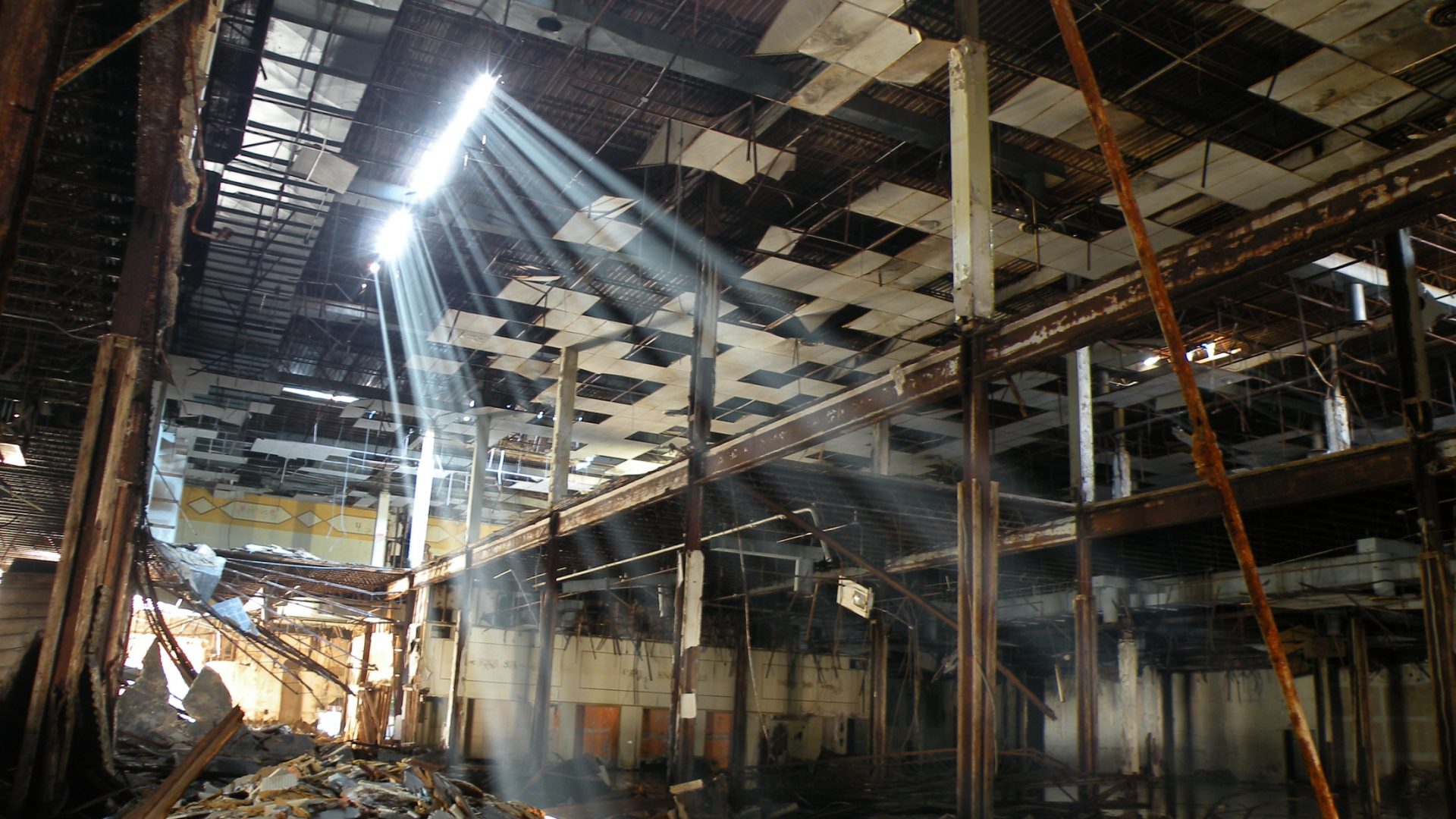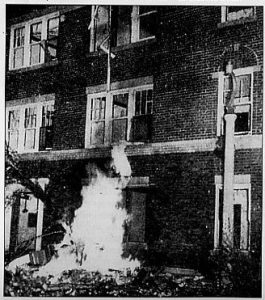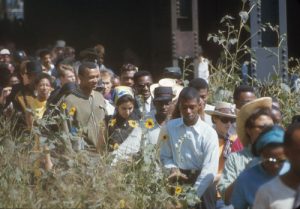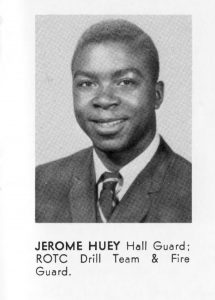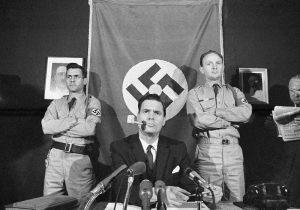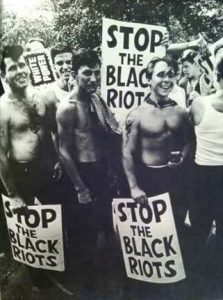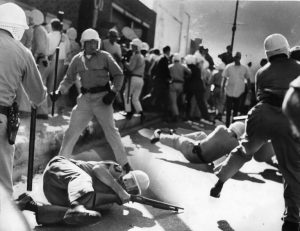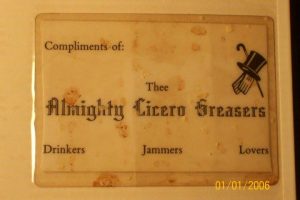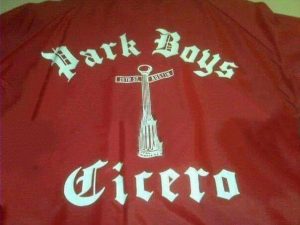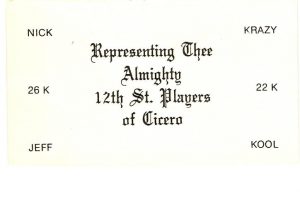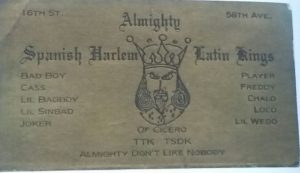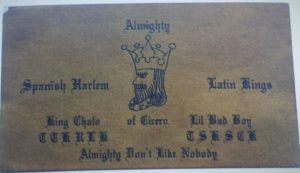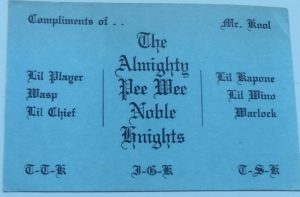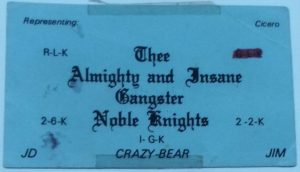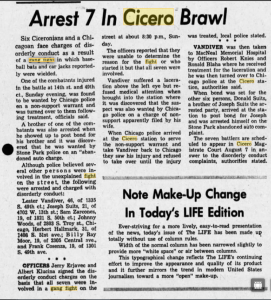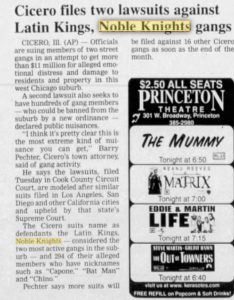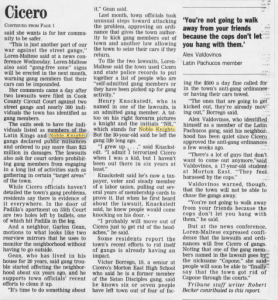| Settled by | Provide info | |
|---|---|---|
| Year infiltrated | 1952 | |
| Crime impact | Part | |
| Worst areas | The highest crime area currently is: Cermak Road on the north, 28th Street on the south, Central Avenue on the east, 59th Court on the west. the next toughest areas that actually were historically the toughest area at times are: The ParkHolme section at 16th Street on the north, Cermak Road on the south, 50th Avenue on the east, 54th Avenue on the west. 31st Street to Central Avenue to 35th Street on the north, Pershing Road on the south, Laramie Avenue on the east, 59th Avenue on the west. The next to toughest area was actually the most violent in the past but now has cleaned up a little but still has higher crime, this is the Grant Works section which is: Roosevelt Road on the north, 16th Street on the south, the Cicero/Chicago border on the east, 50th Avenue on the west |
|
| Suburban projects | None |
When discussing the history of the town of Cicero Illinois, often Al Capone will come up in the conversation. Al Capone became synonymous with Cicero, because he built an empire of organized crime and corruption in this community and even after he passed away and even after organized crime mostly left the western suburban community, his influence remained a part of Cicero. Cicero was the first suburb in the Chicago metro area that had organized crime influence and it also became the first suburb to have a major street gang issues. Cicero is also the first and only suburb in the Chicago metro area to have successful suburban born gangs that have been in existence starting in the late mid-1960s like the Twelfth Streets Player and Noble Knights.
I do not know much about the early history of the first settlers of Cicero. The boundaries for the town were drawn out in 1849 and the name Cicero was decided because it took after the name of Roman statesman Marcus Tullius Cicero that proposed democratic principles in the first century in Rome. By the year 1857 the settlers in this region organized Cicero Township to govern the area and collect taxes for development. In the year 1869 a portion of Cicero Township became the town of Cicero, then in that same year the city of Chicago annexed part of Cicero into the city to become North Lawndale.
In the later decades of the 19th century Cicero became a manufacturing and railroad town and by the 1880s the population boomed, and as the boom happened the city of Chicago wanted to annex more of Cicero, in 1889 Chicago took half of the town then in 1899 another large northern portion was taken away that was absorbed to become the Austin neighborhood. In the year 1901 more annexation away from Cicero happened as Oak Park and Berwyn wanted communities of their own, regardless, of the mass annexations Cicero still remained a larger suburb bordering Chicago.
In the year 1904, Western Electric opened its doors and immediately employed more than 20,000 people who created a massive wave of new residents and construction in Cicero. Many of the newly arrived Cicero residents were eastern European immigrants; there was also a large influx of Italian immigrants.
Industry is not what ended up making the town of Cicero famous; it was organized crime and government corruption then later street gangs that made the suburb notorious. It was in the year 1923 that Chicago outfit boss Johnny Torrio was having major issues with Chicago’s newly elected Mayor William Dever. Dever wanted to clamp down on organized crime and was not to be bought off by the Outfit like previous Mayor William “Big Bill” Thompson could be. Torrio then instructed his right hand man Al Capone to find another base of operation that was outside of the city limits and free of Chicago laws and that was when Al Capone chose the industrial western suburb.
The biggest opportunity for a takeover of Cicero for the Outfit came along in 1924 when it came election time for a new Mayor of the suburb. Joseph Klenha was currently serving on the town committee as the City Manager and when Capone first arrived Klenha was already on the payroll with the Chicago Outfit, now both the Outfit and Klenha wanted the City Manager to become the next Mayor, because a corrupt Mayor would ease the mass expansion of Torrio’s empire into Cicero.
In April of 1924, Al Capone’s brother Frank Capone was in charge of pushing voters to vote for Klenha by any means necessary. If any voters were known to not vote for Klenha they were pushed to vote the other way, and if they refused they were beaten by Capone’s gang of thugs. Capone took over the voting polls, as his henchmen stood guard with Tommy Guns and shotguns telling people to vote Klenha, if people refused they were either beaten on the spot or they were sent home and not allowed to vote. Cicero had 143 saloons where the majority supported and permitted illegal gambling operations in the community and Torrio’s gang wanted to take all of those over, but in order to do so they needed this Republican candidate to win this election.
Rudolph J. Hurt was the Democrat candidate chosen to dare run against Klenha, the Chicago Outfit made Hurt and his campaign managers really suffer for it. March 31st 1924 was complete chaos on the streets of Cicero as rioters supporting both sides clashed and brawled in the streets. On this night of March 31st Al and Frank Capone’s henchmen showed up to the headquarters of Rudolph Hurt and lit the place up in a hail of automatic gun fire, Hurt narrowly escaped as gunman blasted at him nearly mowing him down in a barrage of .45 caliber gun fire from the gangster’s Chicago typewriters of death. In another part of town at 5702 22nd Street which was the office of William K. Pflaum who was Democratic candidate for town clerk, six henchman burst into Pflaum’s office and pistol whipped Pflaum with revolvers, punched the other men in the face at the scene with brass knuckles after they tried to stop the attack, the henchmen then shot bullets into the ceiling then fled the scene all this happened while Pflaum’s wife, sister and son and one other child witnessed the attack. That same March day, five men and a 14 year old boy were attacked by rioters for handing out democrat propaganda (Chicago Tribune Page 1, April 1, 1924). Even Cicero police were not safe if they tried to enforce the law and stop the South Side Gang, officers were beaten just like Democrat voters. A large number of Cicero police were already on the payroll by Capone anyway. Even though Dever was not the Mayor of Cicero and had nothing to do with it, he was still furious about what had been happening in the suburb and that the South Side Gang set up there to avoid Dever’s takedown. Dever then put plain clothed Chicago police into the suburb to do as they pleased. The officers then did not have to follow police procedures in Cicero. The plain clothed cops then drove up to the polling riots at Western Electric and mowed down Johnny Torrios men in an onslaught of gun fire that ended up taking the life of Frank Capone.
When the 1924 election was over with, Klenha won the election, which became a major victory for Johnny Torrio’s South Side Gang. Al Capone got to work taking over one saloon after another, forcing all of them to do business with him. If there was refusal bones were broken or worse lives were taken. Capone visited local bootleggers that supplied many of the saloons and paid many of them off, the ones that refused entered into a losing war with the South Side Gang. Al Capone then took over the Hawthorne Inn at 4835 west 22nd Street and made this the new Cicero headquarters; Cicero was then given the nickname “Caponeville.”
In January 1925, Johnny Torrio stepped down as the boss of the Chicago Outfit after a nearly successful assassination attempt and Al Capone took the reins. Capone’s direct influence over Cicero lasted until he was jailed in the fall of 1931 for tax evasion. With the loss of Capone, Klenha was not re-elected as Mayor in the 1932 election, regardless, the Chicago Outfit kept a strong influence on Cicero for many years to come.
After Al Capone was imprisoned in 1932, Jack Guzik (pictured below) took over Cicero operations and became a slot machine king. The slot machine, also known as the one armed bandit, could be found in just about every saloon in town, and a majority of the profits went straight into the Outfit’s pockets. Guzik had the chief of police and several police officers and Cicero government officials on the payroll. The transition from Capone to Guzik was indeed a smooth one which kept the Outfit running this suburb, controlling the all night saloons and almost all of the gambling. By 1946, the federal government was breathing down the neck of Guzik and his gambling syndicate, and by 1947 Guzik was being brought up on tax evasion charges forcing him to surrender the top Cicero position, the position now went to Joseph “Joey Doves” Aiuppa (pictured below).
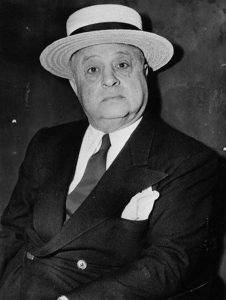
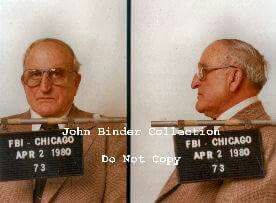
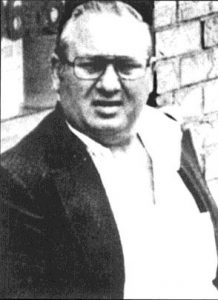
By the time Joey Doves took over, Cicero had become a major money making machine thanks to illegal gambling, slot machines and prostitution. Joey Doves focused much of his energy on “The Strip” which was a stretch along Cicero Avenue of saloons with slot machines and illegal gambling dens; it was also an ideal spot for vice operations. Aiuppa owned several real estate ventures and made that one of his specialties outside of Cicero, he raked in massive profits from this operation, as he also ruled Cicero tightly all throughout the 1950s and 1960s decades. Aiuppa was not known as “Joey Doves” until 1966 when he was actually convicted for attempting to smuggle mourning doves across state lines. Aiuppa was already in hot water with the FBI for smuggling in 563 frozen doves in his car in 1962, that prosecution was stalled but after the incident in 1966 which he violated the Migratory Bird Treaty Act of 1918, he was sentenced to three months in county jail, and that is how the Joey Doves nickname came to be. In 1971, Aiuppa was promoted and became the boss of the entire Chicago Outfit; therefore he left Cicero to James “The Turk” Torello (pictured above) who became the 1970s Cicero mob boss until his death in 1979.
Cicero was not only a mob influenced town, it was also a town that liked to be a white community. African Americans were especially not wanted in this suburb and residents were ready to keep blacks out by any means necessary. One such incident occurred in July of 1951, when a black family moved into an apartment at 6139 west 19th Street. Over 3,000 rioters showed up trying to burn down the building where the black family lived as the National Guard worked tirelessly to put down the riot (pictured below). Harvey E. Clark, a 29 year old bus driver rented the apartment for his family (pictured below), as soon as word got out the black family had moved in a major riot went on outside the building for a few days, as the Clark families’ possessions were smashed and thrown outside the apartment. The Clark family then agreed to evacuate Cicero entirely and African Americans no longer felt like it was safe to move to the suburb.
Cicero has been known as mob town since the early 1920s when Al Capone arrived, but as far as juvenile street gangs are concerned there really were none during the biggest mob years. It was in the year 1952 when greaser gangs began to form in Cicero. This was the same year greaser gangs were forming in the nearby suburb of Berwyn and several other Chicago lands, even Lisle had gangs that early on. No suburb had greaser gangs like Cicero and Berwyn though, this is where some of the toughest and largest greaser gangs manifested. I hardly know any names of gangs in these early days but I piece together gang activity from old newspapers. The most greasers came from the Grant Works area of the suburb as this was the area bordering the Fillmore district of the city of Chicago which had some very tough greaser and white gangs in the 1950s. The intersection of 14th Ave and 49th Street became the wildest intersection that saw the most gang fights for decades starting in 1952. Cicero authorities struggled with gangs of young teens with duck tail haircuts and levi jeans as they fought other gangs viciously. Chicago based greaser gangs would make their way into town and fight it out with Cicero clubs as Cicero gangs often left their stomping grounds to cause trouble elsewhere. Cicero greasers were also into street racing that was often high risk and dangerous. The fights were brutal and sometimes the papers would report a teen or two killed on these streets. The 1950s greasers indeed paved the way of influence for later generations of Cicero gangsters.
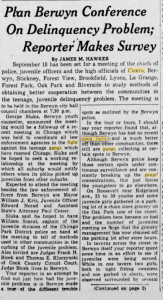

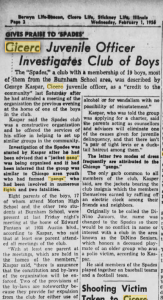
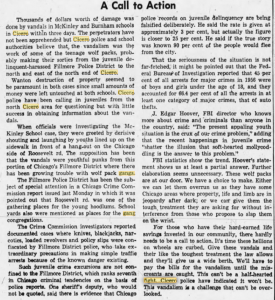
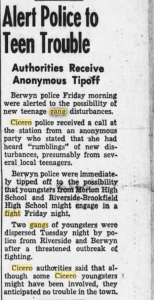
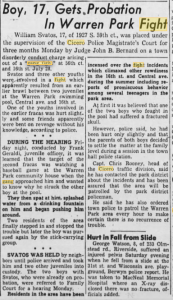
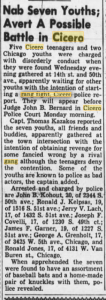


I don’t know why none of the 1950s greaser clubs survived beyond the 1960s but all of the earliest greaser clubs were gone by the later 1960s, perhaps this was because they grew out of it. In the city, very few white greaser gangs stuck around beyond the 60s so that could be expected among Cicero gangs. The other main issue some gangs stuck around into the 1970s was the fact their neighborhoods became infiltrated by Hispanic and black families and it gave them something new to fight for but in Cicero it remained a all-white community well after the 1960s.
The first significant gang activity in Cicero began in the year 1964 when a Greek Latin King “Serbian John” came to Cicero and started the Latin Kings inside the Johnny’s Top Hat night club located at 22nd and Cicero Ave right near the Grant Works section. Johnny’s was an all night club opened into the early morning hours. Serbian John recruited Greek youths from Cicero and among the very small Mexican population of the community. Serbian John was known as a pimp while he led these Latin Kings. This makes the Latin Kings the first gang to settle in Cicero history. This section of Latin Kings only lasted until the early 70s.
In the year 1966 the Ridgeway Lords formed in nearby Little Village and became instantly enthralled by Cicero. Ridgeway Lords were just like the Latin Kings, a mix of Mexican and white youths coming together against common enemies; however, Latin Kings didn’t join the Ridgeway Lords in their battles against Cicero greaser gangs especially since the Latin Kings were trying to remain a part of the Cicero community. Around the same time the Latin Kings and Ridgeway Lords formed a Cicero gang started up called the “Arch Dukes.” There was also the Roman Lords that formed by 1966 as did Arch Dukes and Ridgeway Lords all forming in 1966. I don’t think the Roman Lords lasted more than a few years, the Dukes became the more popular and stronger organization. I am not sure exactly how the rivalry began with the Ridgeway Lords and Arch Dukes but it would eventually became a legendary rivalry between gangs that never shared the same neighborhood.
The rights of African Americans to live in the suburb were tested again in August of 1966 when a Martin Luther King led march (pictured above) was scheduled to occur in the suburb following the beating death of Jerome Huey (pictured above). Huey had simply come to Cicero seeking employment and was inquiring with store owners. A gang of 3 white youths spotted Huey then grabbed a baseball bat and proceeded to beat the 17 year old until he was dead at the intersection of 25th Place and Laramie on May 25, 1966. The reason for the beating was being black in Cicero is the best way to sum it up. Martin Luther King then scheduled a march on the streets of Cicero to the spot where the boy was killed to protest against the unfair treatment of blacks in Cicero and to exploit the extreme hate the community had toward blacks. When it came time for the late August March, King had cancelled the march because of an agreement with Chicago public officials; however, a splinter group out of King’s organization took to the streets themselves without King on Labor day weekend. The Nazi party led by George Lincoln Rockwell (pictured above) attempted to petition to protest on that day as well but city hall rejected their application. Even though the Nazi party was not allowed to protest, they were not needed because there was enough hate in the community driven down on the protesters just from Cicero citizens and greaser gangs (pictured above). As the protesters marched they were greeted by glass bottles, bricks and even firecrackers. The black protesters were spat on and racial slurs were screamed at them, until there was a skirmish (pictured above) at the tail end of the march which caused police officers to suffer injuries.
The march of 1966 brought about more racial tensions between Cicero and the African American community of Chicago. In 1968 those tensions turned into fear right after the assassination of Martin Luther King and the violent riots were ripping through the west side neighborhoods of Chicago. Cicero residents feared the riots would come to Cicero and these riots were much more hostile than the peaceful protest of 1966. The Black P Stones had grown into a very large and complex organization by 1968 and were a major part of the riots; therefore, white youths began to prepare for an invasion of groups like the Black P Stones or the Black Panthers.
In the year 1967, another greaser club formed called the “Cicero Esquires.” The Esquires would prove to be another greaser club formed during these turbulent times when Cicero felt threatened by gangs from Chicago. In this same year the Arch Dukes made the intersection of 61st Avenue and 24th Street their main hangout area at the Our Lady of the Mount Church in the parking lot. This would be their main turf for a long time.
For years the Cicero police officers and local government figures that were free of corruption were hot on the tail of Joey Doves and his gambling syndicate in the suburb but by 1972 the focus needed to shift off of the Outfit and onto street gangs as they were swelling in numbers and were spinning out of control. The Cicero police department now developed 3 special police units that strictly dealt with street gangs. The fact that three units were needed in this community proved how severe Cicero’s gang problem was turning into already, while most other suburbs had no gang activity (Chicago Tribune Page 14, August 19, 1984).
In that same year of 1972, young members of the Arch Dukes wanted to go their own way. The young members of the Arch Dukes started the Noble Knights and Twelfth Street Players out of the legendary greaser stomping ground of Grant Works. All Cicero gangs had a major rivalry with the Ridgeway Lords which were swelling in numbers in Little Village and became one of Little Village’s super gangs. The main reason the Cicero police created these special units was to handle all the rivalry between Cicero and Chicago gangs. The 27th and Homan Latin Kings would come visit Cicero back in these days but Cicero gangs never had a problem with the Kings and actually shared beers with them, this is the foundation of how Noble Knights became tight with Latin Kings.

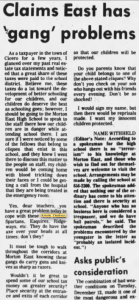
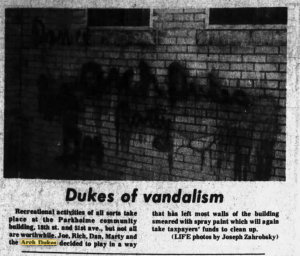
Around 1974, Spanish Lords came into the area but never really set up much of a section in the area, but this was the first signs of Hispanic gang activity although short lived.
For the most part Hispanic gangs from nearby Little Village traveled through Cicero in the mid and late 1970s which often angered greaser gangs. What angered them the most was when Ridgeway Lords and other Hispanic gangs traveled through and by the late 1970s another Hispanic gang was traveling though that Players and Knights didn’t like, the Two Six gang. Two Six was arch enemies with Latin Kings in Little Village and now they became arch enemies with Noble Knights, Arch Dukes and Twelfth Street Players. In the year 1977 both Two Six and Two Two Boys were visiting Cicero more often especially after Two Six became a street gangs in 1977 under direction of the Ayala brothers. The Two Two Boys were formed in 1976 and would soon haunt Cicero as well. Scattered members of the Ridgeway Lords continued to have residence in the suburb during this time too.
In the year 1976 Little Village Latin King gang member Wayne Hastik moved from the city to Cicero at the age of 16. Hastik was well-known in the Latin Kings in Little Village and once war began with Ridgeway Lords that year Hastik was a prime target by the Lords. Hastik’s beef with Ridgeway Lords was reportedly so bad he moved to Cicero to 1416 S. 51st Ave. Hastik befriended Crazy Pete and the Noble Knights. This friendship could be made possible because 27th and Homan Latin Kings had been coming to Cicero to hang out with Noble Knights since 1972. Hastik became one of the first Latin Kings to reside in Cicero.
By the late 1970s Cicero’s gangs became increasingly violent. In 1977 there was a reported 12 gang related shootings, 50 cases of guns fired by gang members and 40 reported gang related stabbings and beatings. In 1978, Cicero police were investigating the vandalizing of 25 stores and restaurants by gang members. Between the years 1977 and 1979 there were a reported 4 gang related homicides in the suburb. The late 1970s violence and heavy gang activity prompted 100 residents in the Grant Works sections to protest at city hall in 1980 that more police protection was needed against the growing gang issues (Chicago Tribune Page 14, August 19, 1984).
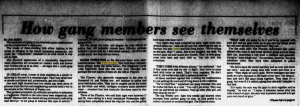
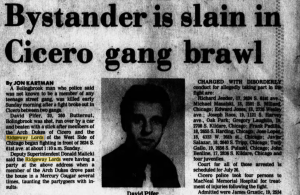
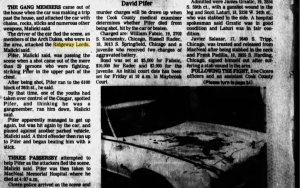

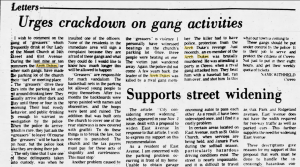
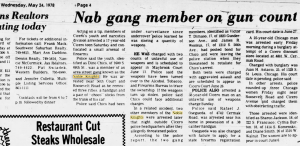
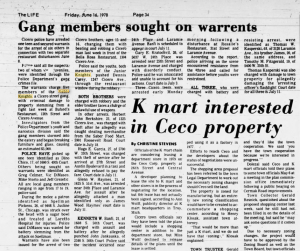
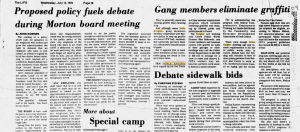
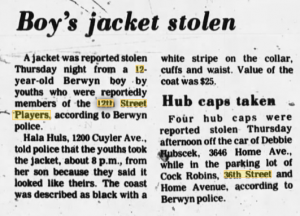
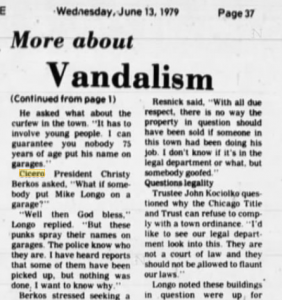
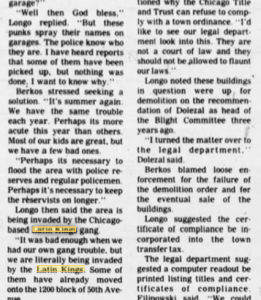
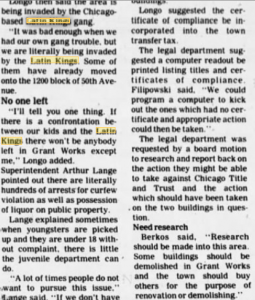

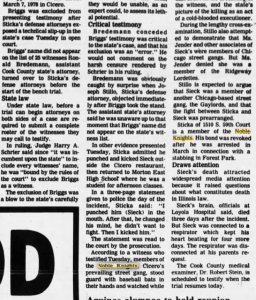
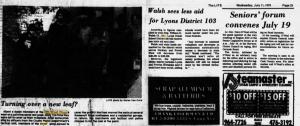
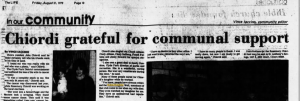
In the year 1979, Twelfth Street Players and Noble Knights began to allow Latin Kings to move into Cicero as Wayne Hastik wanted to establish a section of Latin Kings along 50th Ave to fight against Ridgeway Lords. As soon as Little Village 27th and Homan Latin Kings moved in a score of Latin King graffiti soon popped up heavily in the community that alarmed public officials. Latin Kings had always done business with Noble Knights and Twelfth Street Players in the earlier years of the 1970s so this is what solidified this relationship. Two Six was a fast growing organization and now hanging out more regularly in the village along with Ridgeway Lords so the Latin Kings would be a good ally in battling these enemies. The Latin Kings were settling the area around 50th Avenue and Roosevelt Road. Later into 1979 Ridgeway Lords stormed Wayne Hastik’s home and shot him 16 times with a .22 caliber gun. After the death of Hastik the first Cicero Latin Kings had lost steam in development and focused more on nearby Berwyn.
In January of 1980, as the snow fell on the ground as a new decade dawned, Noble Knights were now the biggest gang as they now began to outnumber the Arch Dukes. Noble Knights now had to deal with new hostile visitors from the Marshall Square area, the Two Two Boys that were coming from 22nd Street and Cicero Avenue. Noble Knights did not take kindly to the visitation of Two Two Boys and they got into immediate skirmishes that led to shootings. Mainly the Two Two Boys were doing more of the shooting as they were heavily armed while the Noble Knights had always been a fighting club. A little later that year members of the Two Two Boys moved to Cicero mainly around the legendary intersection of 14th and 49th in Grant Works, the same corner where Cicero greaser gangs fought legendary battles in the 50s and 60s now the Two Two Boys would fight legendary battles with Noble Knights. The first Mexican families were settling around this area of Grant Works in the year 1980 and this brought much recruitment for Mexican youths that felt bullied by white gangs; although the first recruits for the Two Two Boys were white youths that were referred to as “hillbillies.” Some other Mexican youths arriving in Cicero joined the Latin Kings but most became Two Two Boys. Just two blocks away on 50th and 14th was the Noble Knights so Two Twos and Noble Knights were right by each other.


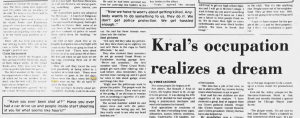
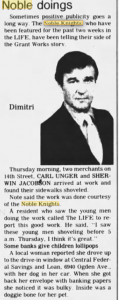
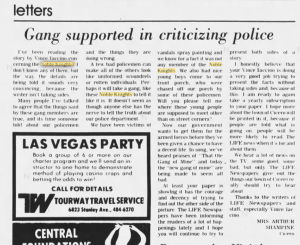
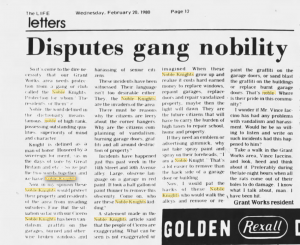
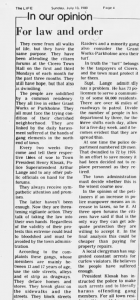
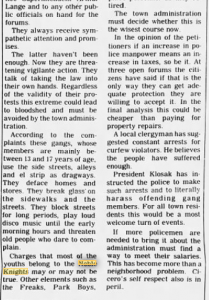
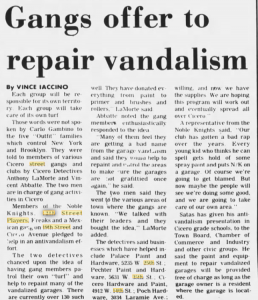

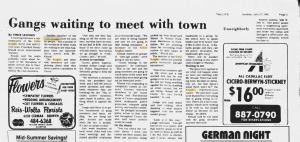
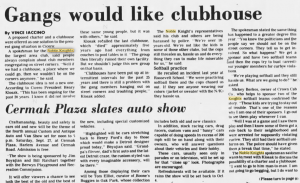

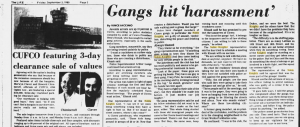


In the same year of 1980, as Mexican families continued to move in from Little Village and Marshall Square, another gang moved into the intersection of 19th and Cicero Avenue and 14th and 49th, a gang that was already well-known and hated by Arch Dukes, Twelfth Street Players and Noble Knights, the Two Six gang. This new Two Six branch did not gain much momentum in the early 1980s and remained rather small but they still had a significant branch with likely more than 10 members that became the notorious “Cicero Two Six” branch. Two Two Boys and Two Six immediately allied up as they both had the same enemies.
In the year 1980 the first member of the Imperial Gangsters moved to Cicero from the city. This Imperial Gangster networked with the Two Sixs because both gangs were part of the Folk alliance alongside Two Six. The Imperial Gangsters mainly cliqued up with the Two Sixs at 14th and 49th as the two gangs became close allies. The Imperial Gangsters would dwell in Cicero through the 1980s but eventually went extinct; however, they were one of the first Chicago based gangs to move into the suburb in the early 1980s.
Rivalry between Two Two Boys and Noble Knights became dangerous as they began shooting at each other and stabbing each other by 1981. The gangs were also frequenting the many all-night bars in the community by 1981, and late into the night hours after many drinks were consumed gang fights, stabbings and shootings began happening outside these bars.
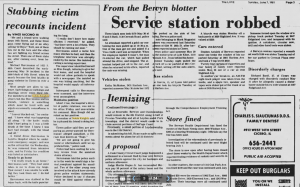
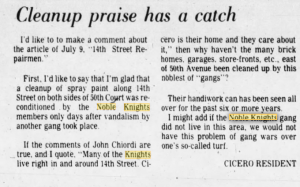

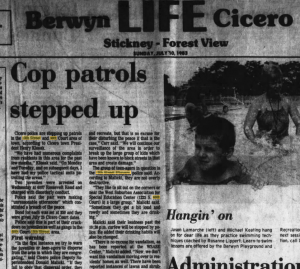
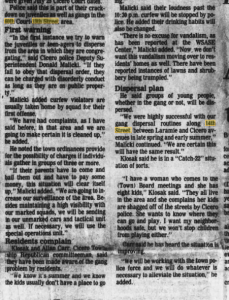
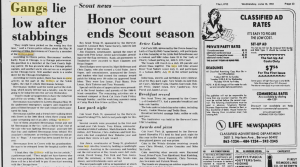
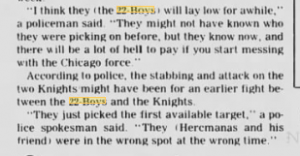
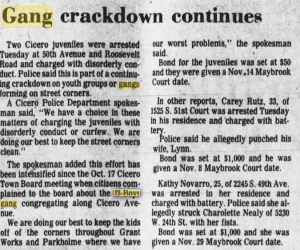
Cicero police were stepping up patrols in the Grant Works section and now dealing with 8 different gangs. The gangs were: Latin Kings, Twelfth Street Players, Noble Knights, Two Six, Two Two Boys, Imperial Gangsters, Park Boys and another gang I don’t know. The new program had police arresting 20-40 individuals every night starting in July 1984. There were 4 major gangs operating in Cicero and 4 other new comers that were growing. The Mayor at the time Henry Klosak had a very tough stance on gangs and referred to them as “punks.” When complaints came in that Cicero police were too harsh on the youths and harassing innocent children, Mayor Klosak’s response was “We know most of these gang members, I tell the parents, if you can’t handle your kids, we will.” These were harsh words that showed there was a new turning point in Cicero law enforcement against gangs that would become legendary (Chicago Tribune Page 14, August 19, 1984).
Latin Kings were given new life in about 1984 when a member of the Coulter Kings Latin King branch from Coulter and Damen in the Pilsen community named Roy “Baretta” Martinez helped start the “Spanish Harlem” Latin Kings in the suburb which would end up becoming the most legendary Latin King branch in the suburb.
Despite heavier police patrols and a tough Mayor the gangs continued to grow in size and became increasingly violent in the mid-1980s. The all night bars were becoming sights of serious violence as nearby residents complained of gang violence outside them and couples having intercourse on front lawns at 6 or 7 in the morning right after the bars finally closed as school children walked by and witnessed it. By 1985 citizens were complaining to city hall about these all night bars, especially Mr. C’s Lounge located at 2421 S. Laramie Ave.
The Noble Knights faded a little more out of the newspapers even though they were growing into their peak in numbers, the spotlight was now on the Twelfth Street Players as they were engaging in major wars with Two Six and Two Two Boys in the mid-1980s. The 1984 murder of Two Two Boy leader Roman Rys made the paper multiple times as the Players were the ones credited with his murder. There were also reports in the mid-80s of several cases of graffiti and vandalism by the gangs during the second half of the 80s especially by Twelfth Street Players.
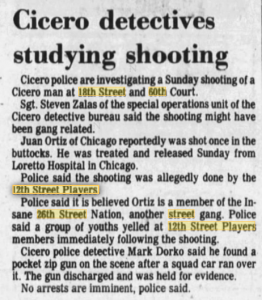
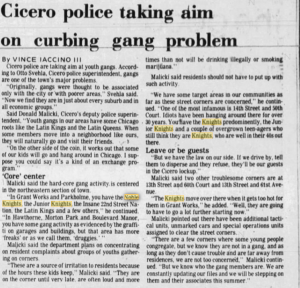
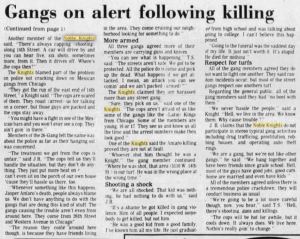


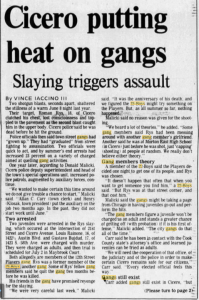
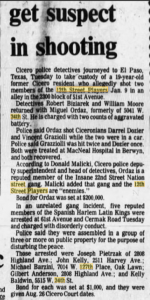
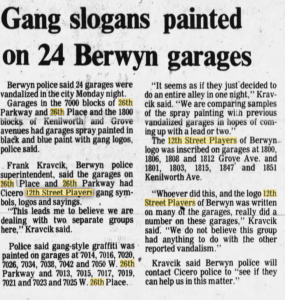
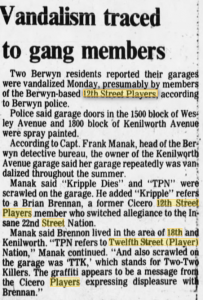
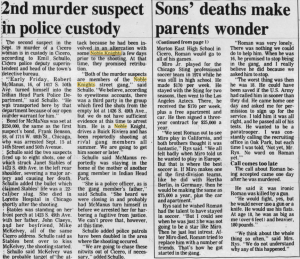
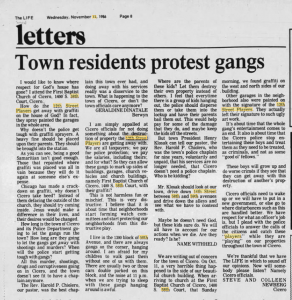
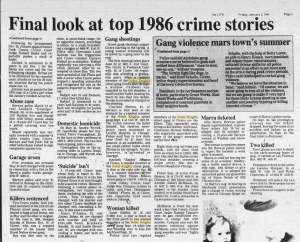
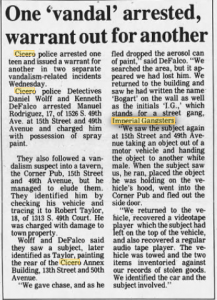


By the late 1980s, gang related violence and recruitment intensified further on the streets of Cicero as now the same 7 out of 8 gangs were still operating by 1989. The Imperial Gangsters had gone extinct by 1989, but the other 7 gangs were operating successfully bringing in heavy recruitment. Many longer time residents of the suburb began packing their bags in the late 1980s as more Mexican families moved in. The property values were lower than ever in Cicero making the area more attractive to lower income Chicagoans.
The Hispanic population had grown from a small percent in 1980 to 40% of the total population of the village by 1992. As new Hispanic families began moving in from the city, new gangs would arrive in this second wave. The earliest arrival among the second wave was the Latin Counts that got fully established here in 1992.
The years 1992-1993 were perhaps the most violent years in the suburb as more new gangs gained a foothold in the community, especially in the Grant Works section. Harrison Gents, Latin Jivers and moved into the suburb from the north side of Chicago while Satan Disciples, Gangster Disciples, Insane Majestics, La Raza and Sin City Boys came from the south side of the city and opened turf in the suburb. Conservative Vice Lords at last opened territory in the suburb from the west side of Chicago. Another Chicago gang came to Cicero in the early 1990s; the Bishops street gang landed at 61st and 24th which was territory the Latin Kings left at that same time. The Bishops were part of the People alliance; therefore, they came in peace with Latin Kings, Twelfth Street Players and Noble Knights.Cicero became a violent war zone with shootings on a daily basis and became just as violent as some of the most dangerous neighborhoods in Chicago. Cicero became a mean and hard suburb and was even feared and respected by Chicago gang members.
The Gangster Disciples from the Hell Zone came from the Gage Park community mainly along 59th street, many of whom were formed G-Town Two Six members that flipped in 1991 and were now also in Cicero in 1992.
The biggest two arrivals the early 1990s were the Satan Disciples and Latin Counts. The Satan Disciples were started by Bobby D and Wakko D in 1992. Two Two Boys and Two Six were engaging is a violent war in the suburb costing many lives and Latin Counts and Satan Disciples were able to grow partially because of that war.
In the mid-1990s more gangs entered the suburb such as: Villa Lobos, Maniac Latin Disciples, Latin Pachucos, Gangster Party People, Mafia Insane Vice Lords, Milwaukee Kings and Ashland Vikings. Maniac Latin Disciples became very popular in the second half of the 1990s while other arrivals like Harrison Gents and Latin Jivers didn’t work out after they arrived in the early 1990s. Gang violence had perhaps hit its peak during these years and law enforcement became extremely tough on gangs, some critics even said it was too tough. Stories flew around that gang members were beaten severely by Cicero police or driven to rival gang neighborhoods and left to their fate. I personally heard a story, not sure if it is true, that back in the 90s police would round up several gang members, cuff them and hit them in their testicles until they dropped, and if they dropped they were beaten badly. I had heard another story that a Two Two Boy was rounded up by police and forced to wear a cardboard sign that said “I hate Bishops” and stand in Bishop’s hood on the corner for quite some time, just like Bruce Willis (pictured) in the movie Die Hard With a Vengeance. I was also told a story once by an acquaintance that had a friend that went to Cicero and got lost, he then pulled up to a gas station to get directions, a gang member overheard he was lost and also spotted a rival gang member at the same time. The gang member that overheard the man was lost pulled out a gun and blew the rival gang members head open killing him instantly then kindly turned to the lost man and gave him directions then said “have a good one” then left. I am not sure if any of those stories are true but I would not doubt that they could be true.
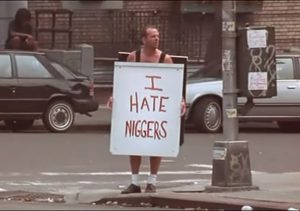
The Cicero streets were indeed tough to deal with for law enforcement so they had to take drastic measure to install any kind of fear into gang members. Government corruption severely inhibited Cicero’s ability to fight crime and gangs in the 1970s, 1980s and 1990s but by the 21st century Cicero began to experience a turn around on crime and gang activity. Cicero’s gang and crime problems have been greatly reduced since the 21st century and the crime rates have even scored low at many points in time.
In the 1960s and 1970s Arch Dukes ruled Cicero but when the Twelfth Street Players and Noble Knights got big in the early 80s those groups then ran Cicero. Two Two Boys got very large and became the first successful Chicago gang to grow heavily in the suburb as they competed heavily with Noble Knights for domination. During the 1980s Two Two Boys and Noble Knights were the biggest gangs. In 1992, several new gangs infiltrated Cicero who happened to be enemies of the Two Two Boys and most were Folk alliance which spelled trouble for Noble Knights. By the mid-1990s many Noble Knights were facing prison time or retired while several Two Two Boys had been killed or put in prison this gave rise to Satan Disciples and Latin Counts. By the late 1990s the Satan Disciples and Latin Counts became the two most powerful gangs in Cicero.
